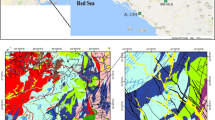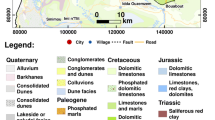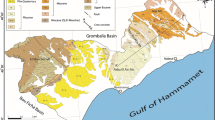Abstract
Tuzla geothermal basin is situated in north-western Turkey on the Biga Peninsula, which is located at the west end of the Northern Anatolian Fault system. Soil and water samples were collected between August 2003 and June 2004 to initiate development of a geochemical profile of surface and subsurface waters in the geothermal basin and radionuclide concentrations in soils. All water samples were found to fall within Turkish Water Quality Class 4, meaning they were remarkably contaminated for any water consumption sector (industrial, human use or agricultural) based on sodium and chloride ions. Such waters could be used only after appropriate water treatment. The water samples are of the chloride type in terms of geochemical evaluation. Preliminary geochemical evidence shows that the N–S flowing part of the Tuzla River acts as a natural barrier within the basin. Heavy metal concentrations in the soil samples show slight elevations, especially those obtained from the east part of the basin where thermal springs are dominant. Geochemical calculations were carried out with PHREEQC® software to determine equilibrium concentration of chemical species and saturation indices, by which it is suggested that chloride is the most important ligand to mobilize the heavy metals in the studied system. In addition, the activity concentration and gamma-absorbed dose rates of the terrestrial naturally occurring radionuclides were determined in the soil using gamma-ray spectrometry. The soil activity ranged from 42.77 to 988.66 Bq kg−1 (averaging 138 Bq kg−1) for 238U, 13.27 to 106.31 Bq kg−1 (averaging 32.42 Bq kg−1) for 232Th, and 99.28 to 935.36 Bq kg−1 (averaging 515.44 Bq kg−1) for 40K. The highest value of 238U was found in the soil samples obtained from an area close to the hot spring.
Similar content being viewed by others
References
Alpan, S. (1975). Geothermal energy exploration in Turkey. 2nd United Nation Symposium on the Development and Use of Geothermal Resources, San Francisco, California, USA, pp. 25–28.
Agency for Toxic Substances and Disease Registry (ATSDR) (1999a). Toxicological profile for aluminum. Atlanta, GA: U.S. Department of Health and Human Services, Public Health Service. Retrieved from http://www.adsdr.cdc.gov/toxprofiles/tp22.html.
Agency for Toxic Substances and Disease Registry (ATSDR) (1999b). Toxicological Profile for cadmium. Atlanta, GA: U.S. Department of Health and Human Services, Public Health Service. Retrieved from http://www.adsdr.cdc.gov/toxprofiles/phs5.html.
Agency for Toxic Substances and Disease Registry (ATSDR) (2000a). Toxicological Profile for chromium. Atlanta, GA: U.S. Department of Health and Human Services, Public Health Service. Retrieved from http://www.adsdr.cdc.gov/toxprofiles/tp7.html.
Agency for Toxic Substances and Disease Registry (ATSDR) (2000b). Toxicological Profile for manganese. Atlanta, GA: U.S. Department of Health and Human Services, Public Health Service. Retrieved from http://www.adsdr.cdc.gov/toxprofiles/tp151.html.
Agency for Toxic Substances and Disease Registry (ATSDR) (2004a). Toxicological Profile for Copper. Atlanta, GA: U.S. Department of Health and Human Services, Public Health Service. Retrieved from http://www.adsdr.cdc.gov/toxprofiles/phs132.html.
Agency for Toxic Substances and Disease Registry (ATSDR) (2004b). Toxicological Profile for strontium. Atlanta, GA: U.S. Department of Health and Human Services, Public Health Service. Retrieved from http://www.adsdr.cdc.gov/toxprofiles/tp159.html.
Agency for Toxic Substances and Disease Registry (ATSDR) (2005a). Toxicological Profile for lead. (Draft for Public Comment). Atlanta, GA: U.S. Department of Health and Human Services, Public Health Service. Retrieved from http://www.adsdr.cdc.gov/toxprofiles/tp13.html.
Agency for Toxic Substances and Disease Registry (ATSDR) (2005b). Toxicological Profile for Zinc. Atlanta, GA: U.S. Department of Public Health and Human Services, Public Health Service. Retrieved from http://www.adsdr.cdc.gov/toxprofiles/tp60.html.
Baba, A. (2003). Geothermal environmental impact assessment with special reference to the Tuzla, Geothermal Area, Canakkale Turkey (pp. 75–114). Iceland: Geothermal Training Programme Book.
Baba, A., & Ármannsson, H. (2006). Environmental Impact of the Utilization of Geothermal Areas. Energy Sources, Part B, 1, 267–278.
Baba, A. & Ozcan, H. (2004). Monitoring and evaluation of the geothermal fluid on soil and water in the Tuzla geothermal field by GIS. Remote sensing and GIS for Environmental Studies, edited by.Stefan Erasmi, Bern Cyffka, Martin Kappas, Göttinger Geographische Abhandlungen, vol. 113, Göttingen, pp. 138–143.
Baba, A., Ozcan, H. & Deniz, O. (2005). Environmental Impact by spill of geothermal fluids at the geothermal field of Tuzla, Canakkale–Turkey. Proceedings World Geothermal Congress 2005 Antalya, Turkey, 24–29 April 2005, pp. 1–8.
Beck, H. L. (1972). The physics of environmental radiation fields. Natural radiation environment II, CONF-720805 P2. Proceedings of the second international symposium on the Natural Radiation Environment.
Dragović, S., & Onjia, A. (2006). Classification of soil samples according to their geographic origin using gamma-ray spectrometry and principal component analysis. Journal of Environmental Radioactivity, 89, 150–158.
Ekingen, A. (1972). Gravimetric survey of Ezine–Ayvacik–Bayramic surroundings, MTA report, no: 4859, Ankara (in Turkish).
ESRI (1996). Using ArcView GIS. Environmental System Research Institute, Redlands, CA.
Gevrek, A. I., & Sener, M. (1985). The determination of hydrothermal alteration zones by clay minerals in Canakkale–Tuzla area. 2nd Turkish National Clay Symposium. Ankara, Turkey: Hacettepe University.
Kara, E. E., Pırlak, U., & Özdilek, H. G. (2004). Evaluation of Heavy Metals' (Cd, Cu, Ni, Pb, and Zn) Distribution in Sowing Regions of Potato Fields in the Province of Niğde, Turkey. Water, Air, and Soil Pollution, 153, 173–186.
Karamanderesi, I. H. & Öngur, T. (1974). The report of gradient wells of Tuzla (Canakkale) geothermal field. MTA report, no: 5524, Ankara (in Turkish).
Krauskopf, K. B. (1967). Introduction to Geochemistry. P721. New York: McGraw-Hill Book Co.
Killeen, P. G. (1979). Gamma ray spectrometric methods in uranium exploration – Application and interpretation, in Geophysics and geochemistry in the search for metallic ores. Geological Survey of Canada Economic Geology Report, 31, 163–229.
Miller, R. W., & Donahue, R. L. (1995). Soils in Our Environment (p. 6497th ed.). Englewood Cliffs, NJ: Prentice Hall.
Mutzenberg, S. R. (1991). Westiche Biga-Halbinsel (Çanakkale, Turkei) Beziehung zwischen Gedogie, Tektonik und Entwicklung der thermalquellen, PhD thesis, ETHD-Zürich, Nr. 287.
Mutzenberg, S. (1997). Nature and origin of the thermal springs in the Tuzla area, Western Anatolia, Turkey, Active Tectonic of Northwestern Anatolia – The Marmara Poly-Project. In C. Schindler & M. Pfister (Ed.), vdf hochschulverlag AG an der ETH (pp. 301–317). Zurich.
Parkhurst, D. L. & Appello, A. A. J. (1999). User's guide to PHREEQC (version 2) – A computer program for speciation, batch reaction, one dimensional transport and inverse geochemical modeling. U.S. Geol. Survey, Water-Resource Invest., pp. 99–4259.
Pehlivan, R. (2003). The effects on human health and hydrochemical characteristics of the Kirkgecit and Ozancik Hot Springs, Canakkale, Turkey. Environmental Geochemistry and Health, 25, 205–217.
Plant, J. A., Kinniburgh, D. G., Smedley, P. L., Fordyce, F. M. & Klinck, B. A. (2004). Arsenic and selenium. Ed.: H.D. Holland and K.K. Turekian in Treatise on Geochemistry, Vol. 9: 17–66, Elsevier. Retrieved from http://www.treatiseongeochemistry.com/.
Samilgil, E. (1966). Hydrogeological report of geothermal energy possibility survey of hot springs of Kestanbol and Tuzla village of Canakkale. MTA report, no: 4274, Ankara.
Sayın, M. (1999). Toprak Mineralojisi. Ç.Ü. Ziraat Fakültesi Genel Yayın No:227, Ders Kitapları Yayın No: A-72, 165s. Adana (in Turkish).
Şener, M., & Gevrek, A. (2000). Distribution and significance of hydrothermal alteration minerals in the Tuzla hydrothermal system, Çanakkale, Turkey. Journal of Volcanology and Geothermal Research, 96, 215–218.
Turkish Official Gazette (2004). Water Pollution Control Regulation. December 31, 2004. No: 25687.
Ulker, I. (1988). Health Tourism and Hot Spring Planning in Turkey. Ministry of Culture and Tourism, No: 1006. Ankara, Turkey (page 63. Total 316 pages).
UNSCEAR (2000). Sources and effects of ionizing radiations. United Nations Scientific Committee on the Effects of Atomic Radiation UNSCEAR 2000 Report to the General Assembly, with scientific annexes, Volume I, United Nations Publications.
Urgun, S. (1971). The geology of Tuzla–Kestanbol (Canakkale) surrounding and geothermal energy possibility, MTA report, no: 4664, Ankara (in Turkish).
Vengosh, A., Helvacı, C., & Karamanderesi, İ. H. (2002). Geochemical constraints for origin of thermal waters from western Turkey. Applied Geochemistry, 17, 163–183.
Author information
Authors and Affiliations
Corresponding author
Rights and permissions
About this article
Cite this article
Baba, A., Deniz, O., Ozcan, H. et al. Geochemical and radionuclide profile of Tuzla geothermal field, Turkey. Environ Monit Assess 145, 361–374 (2008). https://doi.org/10.1007/s10661-007-0045-0
Received:
Accepted:
Published:
Issue Date:
DOI: https://doi.org/10.1007/s10661-007-0045-0




